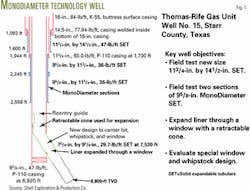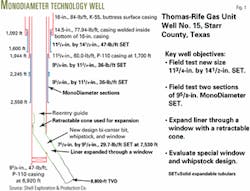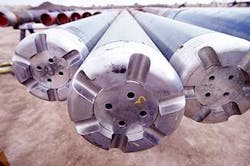Shell drills world's first MonoDiameter well in South Texas
Shell Exploration & Production Co. (Sepco), Houston, announced last month the successful completion of the world's first application of the expandable tubular technology the company calls MonoDiameter.
A collaborative effort of Sepco, Shell International Exploration & Production Inc., and Houston-based Enventure Global Technology LLC, the technology eliminates the telescoping effect in current well design, the companies say, allowing operators to slim down the top of the well while increasing the well diameter at TD.
The Starr County, Tex., Thomas-Rife Gas Unit No. 15 is a Vicksburg gas producer that the company spudded May 18. Drilling and completion of the well employed four of Enventure's Solid Expandable Tubular (SET) casing or liner sections (OGJ, Jan. 21, 2002, p. 33).
Although used to trial test new technology, Sepco completed the well as a gas producer with a fracturing stimulation job within the reservoir, after the rig had run and cemented the combined tubing and production liner and perforated the producing interval.
Game-changing technology
Referring to the South Texas project as groundbreaking well-design technology, the companies say the concept will create a paradigm shift in the petroleum industry that will reduce costs, open previously uneconomic fields, rejuvenate mature reservoirs, and enhance drilling and completion effectiveness.
Starting with 16-in. surface casing that crews extended from 1,092 to 1,600 ft with an expandable liner, the well reached 8,800 ft TD with a 7 5/8-in. by 9 5/8-in. SET liner, expanded through a window cut in 9 5/8-in. casing, ending with 7.674-in., post-expansion ID.
Referring to the process of refining the tools, practices, and operating procedures for use of solid expandable tubulars in the well, Sepco Pres. and CEO Raoul Restucci said, "We tested just about everything."
He explained that the engineers and crews had performed several specific tests involving solid-expandable tubulars and their deployment on the Thomas-Rife project.
Listing various benefits of the technology, the companies said it has the potential to help operators working in deep water, in subsalt zones, and in drilling deep wells that commonly encounter challenges before reaching the planned TD.
Should unexpected drilling problems arise, the companies claim the MonoDiameter technology would provide the operator with greater capability of reaching the planned TD with a casing size large enough to install the planned well completion and allow full production potential from the reservoirs.
Restucci explained that by reducing a well's surface size and reducing the riser size required offshore would allow operators to use smaller, less-expensive rigs, dramatically reducing daily rig costs.
The technology will reduce material usage, costs, and environmental impact. It could shrink the operational footprint on land up to 75%, generate fewer emissions by reducing rig size, consume 20% less drilling mud, and generate up to 50% fewer cuttings, he explained.
Both Restucci and John Darley, Director of Shell Technology Exploration & Production, compared the magnitude of impact they thought MonoDiameter technology would have on the oil and gas industry to the impact that 3D seismic has had on modeling of the subsurface or that horizontal drilling has had on well production.
Restucci said Sepco plans to drill a MonoDiameter well in the Gulf of Mexico in 2003.
New SET size
Fig. 1 shows the Thomas-Rife Gas Unit No. 15 wellbore cross section as it would have appeared prior to final well completion.
The first SET liner that extends the 16-in. surface casing is a new liner size that the companies evaluated for use in what Shell calls the deepwater slim well design.
The 11 3/4-in. by 14 1/2-in., 47-lb/ft SET expanded from 11.0-in. ID to a post-expansion ID of 12.64 in., for an ID expansion ratio of 14.9%.
The first number, 11 3/4 in., refers to the preexpansion OD of the liner; the second number, 14 1/2 in., refers to the OD of the base casing that the liner will expand into.
Because of the unusual size and lack of pipe-handling equipment for 14 1/2-in. casing, company sources explained that two joints of 14 1/2-in. casing welded inside of the 16-in. surface casing allowed use of the common 16-in. casing size but kept the expansion ratio of the 11 3/4-in. by 14 1/2-in., 47-lb/ft SET within acceptable limits.
Fig. 1 shows that the same casing size was run inside of itself. Crews ran 11 3/4-in., 60-lb/ft, P-110 casing through the expanded liner that had also been 11 3/4-in. OD prior to expansion.
The photo of Fig. 2 shows the SET expansion-cone launchers that initiate in situ expansion of the tubulars.
MonoDiameter sections
The companies refer to the 95/8-in. SET liners, which effectively perform the function of extending the intermediate casing string deeper, as the MonoDiameter sections (Fig. 1).
The first 9 5/8-in. SET liner expands and seals to the inside of the 11 3/4-in. intermediate casing. The second 9 5/8-in. SET liner, expanding to the same dimensions as the first, seals into the 9 5/8-in. SET above it.
The 9 5/8 in. by 11 3/4 in., 36-lb/ft, SET liners expand almost 16.6%, from 8.921-in. ID to 10.4-in. ID and 11.1-in. OD.
In the bell shape, where the 9 5/8-in. SET liners overlap, the expansion ratio is even higher at about 23-24%.
For the MonoDiameter sections of the well, crews performed the 9 5/8-in. SET liner expansion process in two stages.
Run in the launcher at the bottom of the liner, the expansion cone for the first pass expands the OD of the 9 5/8-in. SET to the ID of the 9 5/8-in. SET above it.
The rig drills out the casing shoe. A second cone, running from the top down, expands the 9 5/8-in. SET to the final 10.4-in. ID and 11.1-in. OD, which are the same dimensions as the liner above.
Company sources indicated that developers are working on expandable cones that would shorten this process to a single expansion pass from the bottom up.
Once crews had completed the MonoDiameter liners, the rig drilled the well to 6,920 ft and ran 9 5/8-in. casing and cemented it.
Thru-window expansion
To further prove and evaluate expandable-tubular technology, the Thomas-Rife well program included cutting a window in 9 5/8-in. casing and expanding 7 5/8-in. by 9 5/8-in. SET through the window.
Company sources said the test accomplished several objectives at once, testing a newly designed bicentered bit and stabilizer assembly, whipstock, and window configuration.
The test proved that the tools could open the window and hole adequately and that liner expansion through the window would be possible. This part of the test also involved evaluation of a retractable cone.
Once the cone had expanded the 7 5/8-in. liner through the window in the 9 5/8-in. casing, and through the seals that created the liner hanger, engineers retracted the cone elements by dropping or pumping a ball or actuating device into the drill pipe.
Once the cone had retracted, the assembly would pass through the top unexpanded interval of the liner.
Development of the retractable cone adds operational flexibility, allowing operators to stop the expansion process and pull the drillstring and expansion-cone assembly out of the hole.
CRA cased-hole liner
In a separate development last month, Lance Cook, president and CEO of Enventure, highlighted that the operator Nederlandse Aardolie Maatschappij (NAM), a 50-50 joint venture of Royal Dutch/Shell Group and ExxonMobil Corp., had successfully installed a 13% chromium (Cr13) CRA expandable liner in a gas well in the Netherlands' Groningen gas field.
The company installed the liner, that was longer than 6,000 ft, during a workover to increase the wellbore ID and the well's gas deliverability (OGJ, Sept. 16, 2002, p. 37).
Cook said that crews had run and expanded the liner in a single run, to reline production casing so it could be used as the production conduit.
Horizontal cased-hole SET
In yet another development last month, Brunei Shell Petroleum Co. Sdn. Bhd. (BSP) announced that it had installed the world's first horizontal cased- hole SET system, in a workover project that required 1,043 ft of 5 1/2-in. by 7-in. carbon steel expandable liner.
Because of unwanted gas production in a well in the Iron Duke field northwest of Borneo, the company had isolated the lateral with a plug prior to the workover.
Following the workover, with gas- contributing zones isolated behind the liner, engineers perforated three separate oil-producing zones that were located between pairs of seals.
With the gas zones remaining isolated, the company says it was able to produce a significant amount of additional oil.
Cook explained that the job was one of the most complex, stretching the operating envelope of the system. Due to the proximity of the gas to oil-bearing zones, crews had to position the elastomer seals within a tolerance of 6.6 ft.
He highlighted that the job was difficult, given the liner-setting depth of 12,972 ft and considering that the liner had to run uphill in the lateral at an inclination of 105°. With a liner expansion ratio of 11.6%, the propagation force was 94,000 lb.
As of mid-September, Cook said that Enventure has performed 85 SET installations and has expanded over 80,000 ft of pipe.


